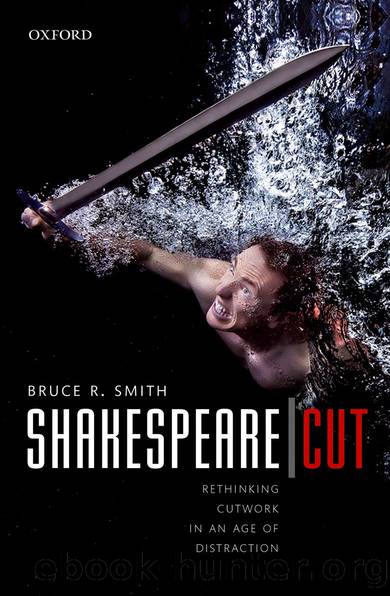Shakespeare | Cut: Rethinking cutwork in an age of distraction by Smith Bruce R.;

Author:Smith, Bruce R.; [Smith, Bruce R.]
Language: eng
Format: epub
ISBN: 9780198735526
Publisher: OxfordUP
Published: 2016-05-24T00:00:00+00:00
Paraphs were used in pen-and-ink technology (we observed in Chapter 2 how horizontal lines separate speech-cuts in the manuscript Book of Sir Thomas More), but they came into greater prominence in print, first as a graphic and then as an indention taking the place of the sign. The inverted commas in the 1676 quarto of Hamlet (see Figure 7A) and in Popeâs 1725 edition of Shakespeareâs plays (see Figure 7B) function as paraphs, as do the horizontal lines that Pope used to relegate unworthy lines and passages in Shakespeareâs text to the bottom of the page. All forms of paraphs are cuts.
=
âCoolâ media and âhotâ media: Marshall McLuhanâs distinction in Understanding Media (1964) is interesting to think about in connection with pen-and-ink technology versus print. McLuhanâs distinction is made according to how much participation a particular medium invites on the part of the perceiver: âAny hot medium allows of less participation than a cool one, as a lecture makes for less participation than a seminar, and a book for less than a dialogueâ (McLuhan 1964: 25). McLuhan regards printed books as a hot medium, and I would agree. A playhouse manuscript in the form of the âbookâ of the play or an actorâs âsideâ requires much more participation than a printed text does. In the âcoolerâ medium of manuscript it is the writer and the user, not a typesetter, who does the cutting.
Nerissaâs pen-and-ink cut of the trial scene in Merchant was enacted whenever an early modern reader chose to write down extracts from Shakespeareâs texts. In transcribing cuts from Shakespeareâs printed texts into their own manuscript âtables,â they were, in McLuhanâs terms, moving Shakespeareâs words from a hot medium into a cool one. Or, rather, back again. All of the verbal cuts from Shakespeare that occur in surviving manuscript miscellanies of the late sixteenth and early seventeenth centuries come from printed sources: Venus and Adonis (1593), The Rape of Lucrece (1594), and sonnets published in the anthology The Passionate Pilgrim (1599), including versions of three sonnets written by the suitors in Act 4, Scenes 2 and 3, of Loveâs Labourâs Lost. But extracts from fourteen of Shakespeareâs plays also figure in these collections (Beale 1980â3: 1:452ff), and they too come from printed texts. An example is Edmund Pudseyâs manuscript book datable to 1609â12 (now Bodleian MS Eng. poet.d.3 and Shakespeare Birthplace Trust ER 82/1/21) containing pen-and-ink cuts from six Shakespeare plays, many of them altered slightly from the quarto texts. Hamlet gets the most sustained attention, but Pudsey writes out five one- and two-line speech-cuts from The Merchant of Venice and sorts them into passions (âaustere,â âpeevishâ), rhetorical occasions (âprotestsâ), topics (âlawsâ), and figures of speech (âsimileâ) (Savage 1887 unpaginated).
Line-cuts and speech-cuts dominate Shakespeare cuts in manuscripts, but there is one famous instance in which a penman has added character-cuts in the form of costumed figures. A single manuscript sheet with an inscribed date of 1595 (Marquess of Bath, Harley Papers, vol. 1, fol. 159v, Foakes 1985: no. 25)
Download
This site does not store any files on its server. We only index and link to content provided by other sites. Please contact the content providers to delete copyright contents if any and email us, we'll remove relevant links or contents immediately.
| Argentina | Bolivia |
| Brazil | Chile |
| Colombia | Ecuador |
| Guyana | Paraguay |
| Peru | Suriname |
| Uruguay | Venezuela |
Cat's cradle by Kurt Vonnegut(14768)
Pimp by Iceberg Slim(13787)
Underground: A Human History of the Worlds Beneath Our Feet by Will Hunt(11842)
4 3 2 1: A Novel by Paul Auster(11800)
The Radium Girls by Kate Moore(11626)
Wiseguy by Nicholas Pileggi(5323)
American History Stories, Volume III (Yesterday's Classics) by Pratt Mara L(5139)
Perfect Rhythm by Jae(5076)
The Fire Next Time by James Baldwin(5024)
Paper Towns by Green John(4805)
Pale Blue Dot by Carl Sagan(4626)
A Higher Loyalty: Truth, Lies, and Leadership by James Comey(4556)
The Mayflower and the Pilgrims' New World by Nathaniel Philbrick(4285)
The Doomsday Machine by Daniel Ellsberg(4250)
Killers of the Flower Moon: The Osage Murders and the Birth of the FBI by David Grann(4192)
Too Much and Not the Mood by Durga Chew-Bose(4097)
The Sympathizer by Viet Thanh Nguyen(4096)
The Borden Murders by Sarah Miller(4025)
Sticky Fingers by Joe Hagan(3916)
